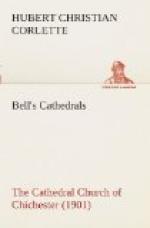The roof of this chapel appears, from the raking channel on the transept wall, to have once been higher, with a sharper pitch. The finish to the present gable point has disappeared. On the east wall and on the south-west buttress of the transept there are two interesting old lead rain-water heads. The east wall of the chapel runs on northwards till it becomes a part of the buttress of the choir. The wall between the north buttress of the chapel and the buttress of the choir aisle close by is pierced with two small cusped windows of fifteenth-century date. Below these is a larger and sharply pointed arched head. It has no mouldings. But the square-headed small light under it has splayed jambs. This opening was probably once a round-headed twelfth-century window, as the old abacus is still in position.
The #South Side of the Choir# is externally divided into five bays. There are five flying-buttresses to carry down the vault thrusts, with a pinnacle above the buttress at the south-east angle. The first, second, and third bays from the east side of the transept have still the round-arched windows of the twelfth century set in the walling of the same date. But it should be noted that part of the window in the first bay was rebuilt after 1861. The fourth and fifth bays have pointed windows, carved capitals, and angle-shafts. These, though now entirely renewed, were built when the whole of this part of the choir was added. Part of the walling for a few feet below the parapet was renewed at the same time. The flying-buttresses are thirteenth-century additions of the same date as the vaults within; and those three nearest the transept abut on parts of the twelfth-century flat buttresses. The flat projection was continued up to the parapet at a later date, probably when the parapet itself was built on. But the fourth buttress also abuts upon a slightly projecting flat strip of buttressing. In this case, however, but not in the others, the flat strip and the flying-buttress are of the same width and built as one piece of structure. The third and fourth flying-buttresses have a secondary, and apparently later, arch of fine grained white stone beneath their larger arches.
The copings on the backs of these buttresses are not weathered like those of the nave, and, except the one next the transept, each is covered with lead. There are no pinnacles to them above the aisle wall. The fourteenth-century builders had not touched them, as they did those south of the nave. There are, too, no gutters along their backs. It is curious that this method of carrying the water away from the upper roofs over the lower ones should not have been adopted when the parapets were put up.
[Illustration: THE CHOIR AND CENTRAL TOWER FROM THE SOUTH-EAST. S.B. Bolas & Co., photo.]




